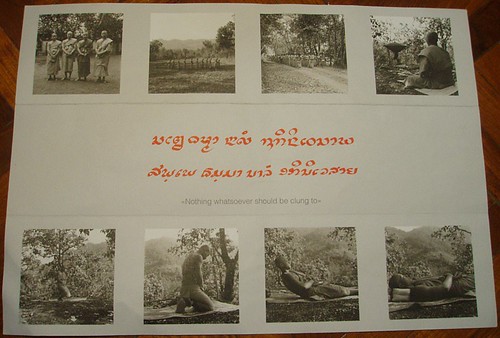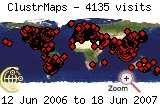
Click here for larger version
At first glance the cat thought that both lines of characters in red were Pali words written using Tham script. Later it realised that the writing in the second line looked a lot more like the modern Lao alphabet than the Lanna alphabet...When the cat's Lao teachers saw the leaflet among the cat's belongings, they pounced upon it with an enthusiasm not seen when faced with their high school Pali homework. They translated the first line as sabbe dhamma nalam abhinivesaya, & the second line as the same Pali words transliterated into Lao as sapphe thammaa naalam aakiniwesaay.
The significance of the quote:
As to what is the heart of Buddhist Teachings, I would like to suggest the short saying, "Nothing whatsoever should be clung to". There is a section in the Majjhima Nikaya where someone approached the Buddha and asked him whether he could summarize his teachings in one phrase and, if he could, what it would be. The Buddha replied that he could: "Sabbe dhamma nalam abhinivesaya". "Sabbe dhamma" means "all things", "nalam" means "should not be", "abhinivesaya" means "to be clung to". Nothing whatsoever should be clung to. Then the Buddha emphasized this point by saying that whoever had heard this core-phrase had heard all the Teachings, who ever put it into practice had practiced all the Teachings, and whoever had received the fruits of practicing this point had received all of the fruits of the Buddhist Teachings.
- from Essential points of the Buddhist teachings by Ajan Buddhadasa (1906-1993)
In the above photo, one minute difference between the second line & 'layman Lao' lies in how the short vowel 'a' is written like a dot beneath the consonant. The only other time the cat has ever seen this is when the Pali names of monks are written in Thai script on transcripts of exam results from Thai Buddhist universities. Another difference is the use of consonants discarded from the modern Lao alphabet (first character of the second word), & also nonextant spelling rules ('aa' in the last word represented by only the letter 'or' - in modern Lao it would be fully spelt out as 'or-aa'). Many of such anachronisms are still retained in modern Thai writing, which makes it much harder to learn to write than Lao. Brings back memories of frequent exclamations by Ajan Titima (author of this great Thai writing workbook) that Thai is a 13th century language! :P
The cat is never the least bit surprised by Thai news reports on how poorly Thai students (especially those in rural schools) fare at writing their own language. Sometimes it wonders if the insistence at clinging onto all the archaic minutiae of their writing system is influenced by a desire to restrict full literacy to a (privileged) highly educated elite...this, in contrast to the efforts of China & Laos to simplify their written languages. Interesting how both the latter are communist....(Although the evolution of simplified Chinese characters predates communism in China, it traces its roots back to the anti-imperialist 五四运动 May Fourth movement.)
The cat is all for the preservation of ancient scripts for historical & cultural reasons, but it believes that literacy for the 'masses' (for want of a better term) is just as important. Quite a few times it has encountered Lao & Thai people unable to make sense of dosage instructions & warnings of side effects & contraindications on medicines (let alone tell apart real from fake medicines, a growing problem in Laos), & warning labels on pesticides & flammables. & getting lost within hospitals, government office complexes & bus stations. & misinterpreting public education posters on nutrition (food pyramid = make pyramid-shaped cabinets for storing food...?), hygiene, parasites, avian influenza, SARS, family planning, human trafficking, land rights, etc.
The list goes on - people not being able to pass driving tests in order to obtain certain types of jobs (though even if they could, red tape & demands for bribes would still stand in the way), nor read statements/reports that police force them to sign. & that family from Kasi district telling a gaggle of tuktuk drivers at Vientiane northern bus station that they need to go to wherever's stated in some official letter that they can't read, & that gaggle of tuktuk drivers having to turn to a bus station staff for help in reading that official letter that they themselves couldn't figure out (destination unknown turned out to be Mahosot Hospital). & people asking the cat if they've boarded the correct bus despite large signboards indicating the destination. & which toilet is the Ladies or Gents even when 'nying' & 'saai' are painted in huge Lao letters outside...
Lao asking non-Lao for help in reading Lao - not too much of a surprise, given the literacy rate, plus how the standard Lao taught in schools is technically a second language for almost half of the citizens, for whom Khmu, Lue, Phouan, Phou Noi, Hmong, Ta Oy, Lanten, Akha, Phoutai, Yao/Mien, Alak, Lahu or some other non-Lao tongue is their first language. The ignorant cat used to wonder why Lao Studies is a compulsory subject for all college & university freshmen in Laos. After all, 'home students' who've cleared their GCE A levels don't have to take compulsory classes in English grammar at UK universities, nor do 'non-international' students in US universities. & then it had a Tai Lue consultant scoring D for Lao Studies due to difficulties with Lao grammar despite having been through 11 years of the Lao education system, & the ethnic & linguistic diversity of the country hit home...a strangely & incredibly familiar situation for the cat, who struggled through 14 years of learning the Mandarin Chinese dialect of Beijing that the ruling party declares to be its 'mother tongue'.
Interesting how not a single family member from its grandparents' generation or older ever knew how to speak Mandarin Chinese, & how those from its parents' generation picked it up only in adulthood. Singapore must be one of the few places on earth where one's 'mother tongue' is officially assigned based on one's officially assigned ethnic classification - regardless of whether anyone in the family can actually speak that language - & where the majority of the citizens study their officially assigned 'mother tongue' as a second language.
Even in Singapore (95.7% literacy), the cat meets people (usually elderly, & including some relatives) caught in some of the situations described above. Over time, the cat realised that when villagers said that it was brave for a girl to travel alone in their countries, safety wasn't the only issue behind that comment. Finding one's way through the bewildering world of the written word littered with signboards, documents, newspapers, timetables, instruction manuals, etc is something many take for granted. Still, in a world where literacy is a key yardstick of achievement & advancement, let us not forget this:
...this [Khmu] visitor [Damrong Tayanin] once delivered a powerful defense of illiteracy, the final message of which was that he pitied the literate who could not remember whatever had not been written down; whose stories were always the same (read from written texts), only as innovative or original as the original author had been; & so forth.
...We need to remember that not all ideas are written down in words...We need to shed our preconceptions...Societies that may be silent in written words are not necessarily stupid or simple.
- from Reading Thai Murals by David K. Wyatt (1937-2006)
After all, how many of us can name every single one of our direct male ancestors like Akha men, or recount our history (including every single village our direct ancestors have ever migrated through) like the pima of Akha villages in Burma, Thailand, Laos & China, & the griots of West Africa, or recall an entire pharmacopeia like Akha & Lahu herbalists, without having to refer to books & documents? What have we lost in gaining the ability to write?






No comments:
Post a Comment